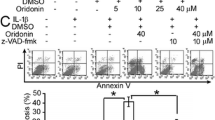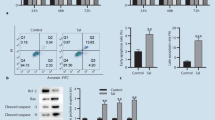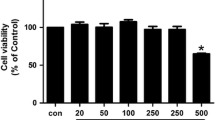Abstract
Objectives
Recent studies have indicated that piperlongumine (PLM) may exert anti-inflammatory effects. In the present study, we determined the effect of PLM on the proliferation, apoptosis, migration and invasion of fibroblast-like synoviocytes (FLS) from patients with rheumatoid arthritis (RA) (referred to herein as RA FLS). We further explored the mechanisms by which the studied compound inhibits the functions of RA FLS.
Methods
RA FLS viability and apoptosis were tested using MTT and Annexin V/PI assays, respectively. We performed an EDU assay to examine the proliferation of RA FLS. The migration and invasion of these cells were measured using a transwell chamber method and wound closure assay. The MMP-1, MMP-3, and MMP-13 levels in the culture supernatants of RA FLS were detected using a Luminex Assay kit. The intracellular ROS levels were detected using DCFH-DA. The expression levels of signal transduction proteins were measured using western blot.
Results
We found that PLM induced apoptosis in RA FLS at concentrations of 15 and 20 μM. The proliferation of RA FLS was downregulated by PLM at concentrations of 1, 5 and 10 μM. Migration and invasion of RA FLS were reduced by PLM at concentrations of 1, 5 and 10 μM. PLM also inhibited cytoskeletal reorganization in migrating RA FLS and decreased TNF-α-induced intracellular ROS production. Moreover, we demonstrated the inhibitory effect of PLM on activation of the p38, JNK, NF-κB and STAT3 pathways.
Conclusions
Our findings suggest that PLM can inhibit proliferation, migration and invasion of RA FLS. Moreover, these data suggests that PLM might have therapeutic potential for the treatment of RA.






Similar content being viewed by others
References
Smolen JS, Aletaha D, Koeller M, Weisman MH, Emery P. New therapies for treatment of rheumatoid arthritis. Lancet. 2007;370(9602):1861–74.
Bartok B, Firestein GS. Fibroblast-like synoviocytes: key effector cells in rheumatoid arthritis. Immunol Rev. 2010;233(1):233–55.
Mor A, Abramson SB, Pillinger MH. The fibroblast-like synovial cell in rheumatoid arthritis: a key player in inflammation and joint destruction. Clin Immunol. 2005;115(2):118–28.
McInnes IB, Schett G. The pathogenesis of rheumatoid arthritis. N Engl J Med. 2011;365(23):2205–19.
Hammaker D, Sweeney S, Firestein GS. Signal transduction networks in rheumatoid arthritis. Ann Rheum Dis. 2003;62:86–9.
Bezerra DP, Pessoa C, de Moraes MO, Saker-Neto N, Silveira ER, Costa-Lotufo LV. Overview of the therapeutic potential of piplartine (piperlongumine). Eur J Pharm Sci. 2013;48(3):453–63.
Adams DJ, Dai M, Pellegrino G, Wagner BK, Stern AM, Shamji AF, et al. Synthesis, cellular evaluation, and mechanism of action of piperlongumine analogs. Proc Natl Acad Sci USA. 2012;109(38):15115–20.
Raj L, Ide T, Gurkar AU, Foley M, Schenone M, Li XY, et al. Selective killing of cancer cells by a small molecule targeting the stress response to ROS. Nature. 2011;475(7355):231–4.
Sun LD, Wang F, Dai F, Wang YH, Lin D, Zhou B. Development and mechanism investigation of a new piperlongumine derivative as a potent anti-inflammatory agent. Biochem Pharmacol. 2015;95(3):156–69.
Arnett FC, Edworthy SM, Bloch DA, McShane DJ, Fries JF, Cooper NS, et al. The American Rheumatism Association 1987 revised criteria for the classification of rheumatoid arthritis. Arthritis Rheum. 1988;31(3):315–24.
Xiao Y, Liang L, Huang M, Qiu Q, Zeng S, Shi M, et al. Bromodomain and extra-terminal domain bromodomain inhibition prevents synovial inflammation via blocking IkappaB kinase-dependent NF-kappaB activation in rheumatoid fibroblast-like synoviocytes. Rheumatology (Oxford). 2016;55(1):173–84.
Firestein GS. Invasive fibroblast-like synoviocytes in rheumatoid arthritis. Passive responders or transformed aggressors? Arthritis Rheum. 1996;39(11):1781–90.
Son DJ, Kim SY, Han SS, Kim CW, Kumar S, Park BS, et al. Piperlongumine inhibits atherosclerotic plaque formation and vascular smooth muscle cell proliferation by suppressing PDGF receptor signaling. Biochem Bioph Res Co. 2012;427(2):349–54.
Chen Y, Liu JM, Xiong XX, Qiu XY, Pan F, Liu D, et al. Piperlongumine selectively kills hepatocellular carcinoma cells and preferentially inhibits their invasion via ROS-ER-MAPKs-CHOP. Oncotarget. 2015;6(8):6406–21.
Tolboom TCA, Pieterman E, van der Laan WH, Toes REM, Huidekoper AL, Nelissen RGHH, et al. Invasive properties of fibroblast-like synoviocytes: correlation with growth characteristics and expression of MMP-1, MMP-3, and MMP-10. Ann Rheum Dis. 2002;61(11):975–80.
Rosengren S, Boyle DL, Firestein GS. Acquisition, culture, and phenotyping of synovial fibroblasts. In: Cope AP, editor. Methods in molecular medicine. Totowa; 2007. pp. 365–75.
Xiao YJ, Shi MH, Qiu Q, Huang MC, Zeng S, Zou YY, et al. Piperlongumine suppresses dendritic cell maturation by reducing production of reactive oxygen species and has therapeutic potential for rheumatoid arthritis. J Immunol. 2016;196(12):4925–34.
Suzuki M, Tetsuka T, Yoshida S, Watanabe N, Kobayashi M, Matsui N, et al. The role of p38 mitogen-activated protein kinase in IL-6 and IL-8 production from the TNF-alpha- or IL-1 beta-stimulated rheumatoid synovial fibroblasts. Febs Lett. 2000;465(1):23–7.
Zwerina J, Hayer S, Redlich K, Bobacz K, Kollias G, Smolen JS, et al. Activation of p38 MAPK is a key step in tumor necrosis factor-mediated inflammatory bone destruction. Arthritis Rheum. 2006;54(2):463–72.
Han ZN, Chang LF, Yamanishi Y, Karin M, Firestein GS. Joint damage and inflammation in c-Jun N-terminal kinase 2 knockout mice with passive murine collagen-induced arthritis. Arthritis Rheum. 2002;46(3):818–23.
Han ZN, Boyle DL, Chang LF, Bennett B, Karin M, Yang L, et al. c-Jun N-terminal kinase is required for metalloproteinase expression and joint destruction in inflammatory arthritis. J Clin Invest. 2001;108(12):73–81.
Pillinger MH, Rosenthal PB, Tolani SN, Apsel B, Dinsell V, Greenberg J, et al. Cyclooxygenase-2-derived E prostaglandins down-regulate matrix metalloproteinase-1 expression in fibroblast-like synoviocytes via inhibition of extracellular signal-regulated kinase activation. J Immunol. 2003;171(11):6080–9.
Miagkov AV, Kovalenko DV, Brown CE, Didsbury JR, Cogswell JP, Stimpson SA, et al. NF- B activation provides the potential link between inflammation and hyperplasia in the arthritic joint. Proc Natl Acad Sci USA. 1998;95(23):13859–64.
Aggarwal BB. Tumour necrosis factors receptor associated signalling molecules and their role in activation of apoptosis, JNK and NF-kappa B. Ann Rheum Dis. 2000;59:6–16.
McIntyre KW, Shuster DJ, Gillooly KM, Dambach DM, Pattoli MA, Lu P, et al. A highly selective inhibitor of I kappa B kinase, BMS-345541, blocks both joint inflammation and destruction in collagen-induced arthritis in mice. Arthritis Rheum. 2003;48(9):2652–9.
Krause A, Scaletta N, Ji JD, Ivashkiv LB. Rheumatoid arthritis synoviocyte survival is dependent on Stat3. J Immunol. 2002;169(11):6610–6.
Son Y, Cheong Y-K, Kim N-H, Chung H-T, Kang DG, Pae H-O. Mitogen-activated protein kinases and reactive oxygen species: How can ROS activate MAPK pathways? J Signal Transduct. 2011;2011:1–6.
Morgan MJ, Liu ZG. Crosstalk of reactive oxygen species and NF-kappaB signaling. Cell Res. 2011;21(1):103–15.
Liu H, Liu X, Zhang CD, Zhu HF, Xu Q, Bu YQ, et al. Redox imbalance in the development of colorectal cancer. J Cancer. 2017;8(9):1586–97.
Acknowledgements
The authors would like to thank Jinjin Fan for her technical assistance.
Funding
This work is supported by grants from National Natural Science Foundation of China (Grant numbers 81373182, U1401222, 81501389 and 81671591), Guangdong Natural Science Foundation (Grant numbers S2011020002358, S2013010015363, and 2014A030310124) and Guangdong Project of Science and Technology (Grant numbers 2014A020212119, 2016A020215051 and 2016A020215043).
Author information
Authors and Affiliations
Corresponding author
Ethics declarations
Conflict of interest
No conflict of interest has been declared by authors.
Additional information
Responsible Editor: Jason J. McDougall.
Rights and permissions
About this article
Cite this article
Xu, S., Xiao, Y., Zeng, S. et al. Piperlongumine inhibits the proliferation, migration and invasion of fibroblast-like synoviocytes from patients with rheumatoid arthritis. Inflamm. Res. 67, 233–243 (2018). https://doi.org/10.1007/s00011-017-1112-9
Received:
Revised:
Accepted:
Published:
Issue Date:
DOI: https://doi.org/10.1007/s00011-017-1112-9




